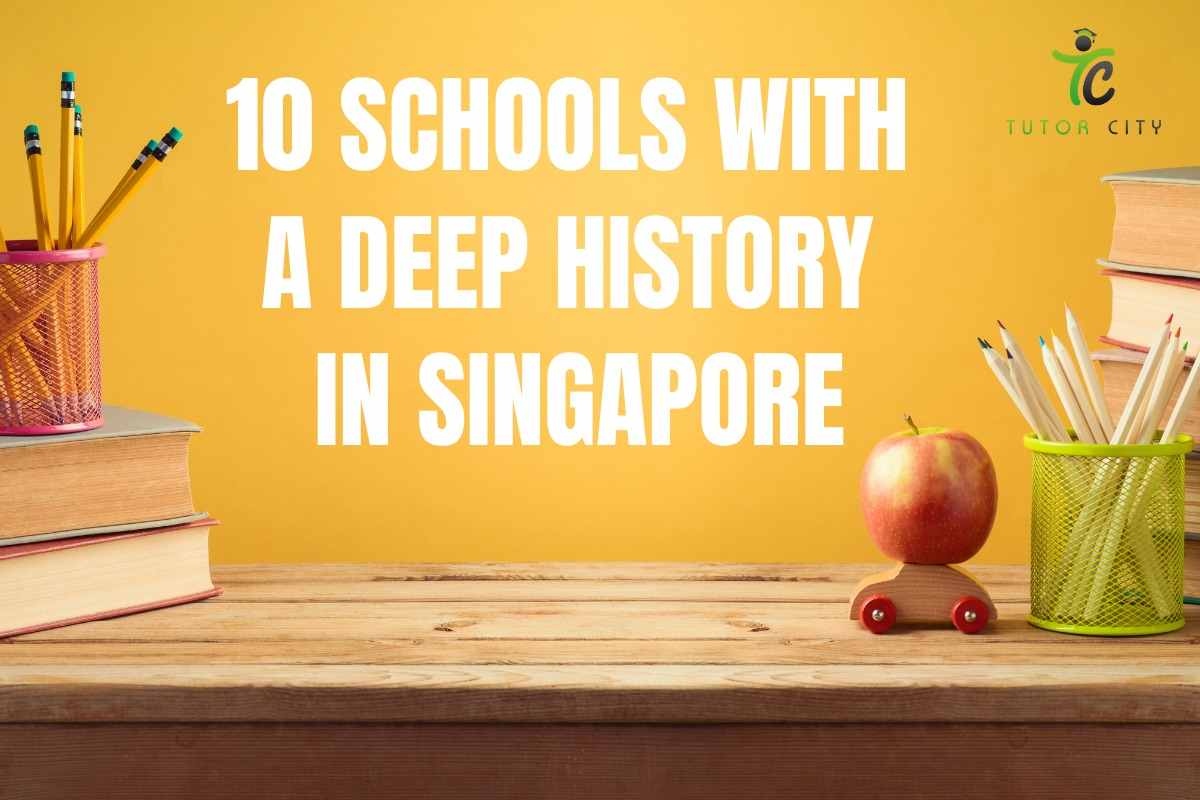
- Published by: Tutor City
- December 10, 2020
- Education
10 schools with a deep history in Singapore
Although Singapore is a relatively young country when compared to others, this nation still has quite a vast and impressive history. And this history includes schools that played an integral part in shaping Singapore and its citizens.
It goes without saying that the quality of educational institutions has a deep and profound effect on the way citizens of a certain country think and on their worldview. The 10 schools listed below played an important role in the lives of the students that attended them and thus, by shaping their students into educated individuals they have played a significant role in the development of Singapore as a nation.
Today these schools provide their students with high-quality education and enable them to achieve their academic goals by paving a way to some of the prestigious universities in the world.
Of course, there are many more prominent schools in Singapore nowadays, but we have selected the 10 historically most significant ones, whose past is deeply intertwined with the history of this country.
Throughout the years these 10 historic schools have been through a multitude of changes: they have changed names, changed their policies, some moved to a different location, and they have even survived a war. Despite all these shifts, they keep standing and producing highly-educated alumni.
So without further ado, let’s have a look at the history behind the 10 historic schools in Singapore.
- St Margaret’s School.
Saint Margaret’s School is the oldest school for girls in entire Southeast Asia. It was established in the 1800s (178 years ago, to be exact). And it all happened thanks to the British missionary whose name was Mrs. Maria Dyre.
In 1842 Mrs. Dyer was traveling to China and she happened to stop over in Singapore where she was confronted with the harsh reality of the condition the young girls were living in. Many of them were trafficked for rich families and made into servants. Rather than turning a blind eye to these horrific events and continuing on her merry way, Mrs. Dyer decided to give these girls a proper home and educate them.
After a short while, Chinese men from the nearby regions started marrying the school's graduates and it soon became popular as a place that produced “wife material“.
Initially, it was called Chinese Girls' School but over a century after its establishment (in 1949) it was renamed Saint Margaret’s School in honor of Queen Margaret of Scotland.
- St. Josephs's Institution.
Saint Josephs's Institution was founded in 1852. It is the oldest Catholic school in Singapore and the third oldest school in the country overall.
It was founded by Father Jean-Marie Beurel who wanted to establish a Christian school for boys in Singapore. He believed that the school would help him promote the Catholic mission and it was meant to be an addition to the church which was built in 1847.
Previously the school was known as St. Johns's School and later it was renamed in 1867.
The previous campus of the school was turned into a national monument in 1992 four years after the school had moved to a different location on Malcolm Road in 1988.
- Methodist Girls' School.
Methodist Girls' School was founded by an Australian missionary called Sophia Blackmore in 1887. She came to Singapore after receiving an invitation from Reverend Oldham who asked her to set up a school for the daughters of Indian fathers who wished their female children to be educated. When it first opened Methodist Girls' School was called Tamil Girls' School. The school was given its current name after it merged with another English-speaking girls' school.
In 1891 girls from other ethnic groups started enrolling in school and the number of students increased greatly.
- St. Andrew's School.
St. Andrew's School was founded in Singapore in 1860 (158 years ago). Back then it was known as the Sim Quee’s School and it was rather small and quaint. Sim Quee one, of its founders, was appointed to be the first headmaster on September 8, 1862.
The school continued growing and within a year they had to move to a new location to accommodate the increasing number of students.
And 10 years after it was founded the school managed to secure government funding.
- Anglo Chinese School.
Anglo Chinese School was also founded in the 19th century (1886 to be exact) by Bishop William Fitzjames Oldham. Initially, it had only 13 students, however, within a year the enrollment increased by so much that the school had to move to a new location. At that time it was thought to be the largest educational project not only in Singapore but the entire British Malaya.
What today is known as ACS Independent, came from the secondary school cohort, and the Junior College section branched out to form the English Chinese Junior College in 1977.
However, both of these educational institutions share the same school motto “the best is yet to be”.
- Raffles Institution.
Although Saint Margaret's School is considered to be the oldest girls' school in Singapore it is not in the old school overall. This accolade goes to the Raffles Institution which was founded in 1823 by Sir Stamford Raffles.
The school itself was founded in 1823, however, due to the construction works and issues with funding the actual teaching was delayed by many years, and the school was finally able to accept its first students in 1834.
The school was given its current name in 1868, before that it was known as the Singapore Free School.
Since it was established Raffles Institution has produced several notable alumni. In fact, Singapore‘s first two presidents and many other prominent politicians have attended the school.
- Nanyang Girls’ School.
Nanyang Girls’ School was founded by a man named Sun Yat-Sen in 1917. Sun Yat Sen was a Chinese revolutionary who played a major role in the successful toppling of the Qing dynasty which led to the establishment of the Republic of China.
When Sun-Yat Sen visited Singapore in 1910 he noticed that Singaporean women were not taking part in the revolutionary movement which was happening in China. Sun Yat-Sen believed that if more women were provided with a high-quality education in Singapore they would be able to participate in the political processes. Thus he successfully convinced the Chinese United League in Singapore to promote women’s education in the country.
By 1946 the Nanyang Girls’ School had approximately 1400 students which at that time made it one of the largest Chinese schools in Singapore.
- Convent of the Holy Infant Jesus Schools.
Most Singaporeans are aware that there is more than one Convent of the Holy Infant Jesus School in Singapore. In fact, 11 different schools carry that name (they include both primary and secondary schools). This school was founded by Father Jean-Marie Beurel (the same person who founded the Saint Joseph’s institution). His desire to educate girls prompted the Father to write to Jesus Sisters in France. He asked them to send nuns to Singapore to set up a school for girls. Sisters agreed and arrived in Singapore in 1854 and started living at Caldwell House which became a safe space for orphans to live and learn from the sisters. After some time, the school had to relocate to make way for some new developments. We have a write-up on 4 reasons why you should enroll in CHIJ Katong Convent Secondary school.
- Gan Eng Seng School.
Gan Eng Seng School is the first school that was founded and is supported by a Chinese benefactor and philanthropist. The school opened its doors to the first students in 1885. Initially, it was known as Anglo-Chinese Free School, and eventually, it was renamed in honor of its founder Gan Eng Seng. Gan Eng Seng was a prominent businessman whose goal was to establish a school for those who were less fortunate so that they could learn Chinese and English. At the time of its foundation, Gan Eng Seng School was the only educational institution that offered bilingual education. In 1987 the school started accepting girls.
- Outram Secondary School.
Outram Secondary School first opened its doors to students in 1906. It was established by then-Governor John Anderson. This is one of the first schools which was built before Singapore’s independence by the colonial government.
Outram Secondary School (which was initially called Outram Road School) was created to accommodate the rising need for the English language.
Unfortunately, many of the school records between 1906 and 1942 were destroyed due to Japanese bombings during WWII.
Initially, this was a primary school and later it was converted into a secondary school in 1954. Four years after the conversion in 1958 the school started admitting girls for the first time. Also, Outram Secondary School became the first school in Singapore with a short-course swimming pool in 1977.
To conclude, Singapore boasts a plethora of historically significant schools that helped shape its citizens thus playing an important role in shaping the country's history. And these schools will continue to produce graduates that will shape the course of the country for many decades to come.
Read also:
The Best Primary schools in Singapore
Choosing between elite schools vs neighbourhood schools in Singapore






